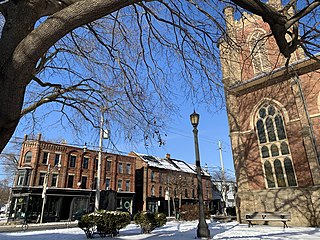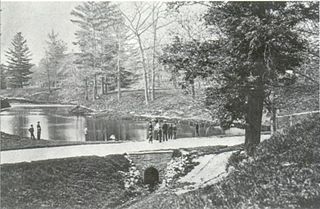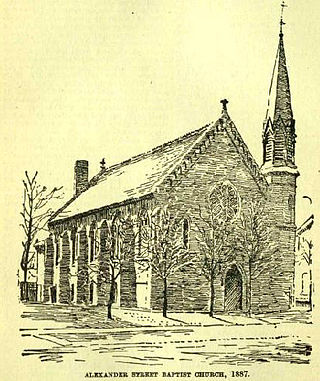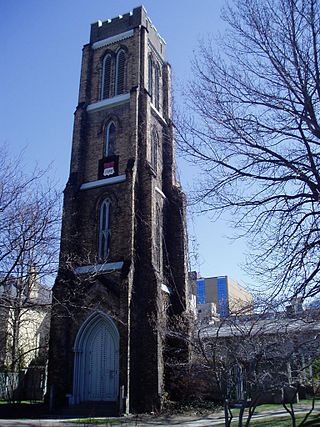
The Village at Black Creek, previously Black Creek Pioneer Village, and before that Dalziel Pioneer Park, is an open-air heritage museum in Toronto, Ontario, Canada. The village is located in the North York district of Toronto, just west of York University and southeast of the Jane and Steeles intersection. It overlooks Black Creek, a tributary of the Humber River. The village is a recreation of life in 19th-century Ontario and gives an idea how rural Ontario might have looked in the early-to-mid-19th century. The village is a regular destination for field trips by schoolchildren from the Greater Toronto Area. It was opened in 1960 and is operated by the Toronto and Region Conservation Authority.

Corktown is an older residential neighbourhood in downtown Toronto, Ontario, Canada. The neighbourhood is south of Shuter Street, north of the Gardiner Expressway, east of Parliament Street, and west of Don River to the east. Corktown contains many vacated industrial buildings, some now used for movie production, and others repurposed for studios and shops. The West Don Lands development is in the south-east corner of this area.

St. Michael's Cathedral Basilica is the cathedral church of the Roman Catholic Archdiocese of Toronto, Canada, and one of the oldest churches in Toronto. It is located at 65 Bond Street in Toronto's Garden District. St. Michael's was designed by William Thomas, designer of eight other churches in the city, and was primarily financed by Irish immigrants who resided in the area. The cathedral has a capacity of 1600. John Cochrane and Brothers undertook the work on the stone and stucco ornamentation of the interior.

The Church of the Holy Trinity is an Anglican church located at Trinity Square in Toronto, Ontario, Canada.

Taddle Creek is a buried stream in Toronto, Ontario, Canada that flowed a southeasterly course about six kilometres long, from St. Clair Avenue west of Bathurst Street through the present site of Wychwood Park, through the University of Toronto, into the Toronto Harbour near the Distillery District. During the 19th century, it was buried and converted into an underground sewer, but traces of the creek can still be found today. The scenic footpath known as Philosopher's Walk follows the ravine created by the creek from the Royal Ontario Museum to Trinity College. Taddle Creek is also the name of a Toronto literary magazine and of a local Montessori school.

Government House was the official residence of the lieutenant governor of Upper Canada and Ontario, Canada. Four buildings were used for this purpose, none of which exist today, making Ontario one of four provinces not to have an official vice-regal residence.

The Ontario Heritage Trust is a non-profit agency of the Ontario Ministry of Tourism and Culture. It is responsible for protecting, preserving and promoting the built, natural and cultural heritage of Canada's most populous province, Ontario.

Factory Theatre is a theatre in Toronto, Ontario, Canada. It was founded as Factory Theatre Lab in 1970 by Ken Gass and Frank Trotz, and it was run for almost 20 years by Dian English.

Little Trinity Anglican Church is a parish church of the Anglican Church of Canada. It is located at 425 King Street East in the Corktown neighbourhood, just east of downtown Toronto, Ontario, Canada. An Ontario Heritage Trust plaque at the site notes that the 1844 church is the oldest surviving church in the city.
The Diocese of Toronto is an administrative division of the Anglican Church of Canada covering the central part of southern Ontario. It was founded in 1839 and is the oldest of the seven dioceses comprising the Ecclesiastical Province of Ontario. It has the most members of any Anglican diocese in Canada. It is also one of the biggest Anglican dioceses in the Americas in terms of numbers of parishioners, clergy and parishes. As of 2018, the diocese has around 230 congregations and ministries in 183 parishes, with approximately 54,000 Anglicans identified on parish rolls.

Downtown Toronto is the main city centre of Toronto, Ontario, Canada. Located entirely within the district of Old Toronto, it is approximately 16.6 square kilometres in area, bounded by Bloor Street to the northeast and Dupont Street to the northwest, Lake Ontario to the south, the Don Valley to the east, and Bathurst Street to the west. It is also the home of the municipal government of Toronto and the Government of Ontario.
William Hay was a Scottish architect who was actively working internationally from 1842 to 1887. A specialist in gothic architecture, he is primarily known for his work on several churches and cathedrals. His most famous structure is the Bermuda Cathedral in Hamilton, Bermuda, which he designed in 1885. Construction of the cathedral began in 1886 and was completed seven years after Hay's death in 1905. He also designed some of the oldest buildings and structures in Toronto, Ontario, from 1853 to 1861, and was responsible for the restoration of St. Giles' Cathedral in Edinburgh from 1872 to 1884. His career exemplifies how the British Empire of the Victorian era was united not only by military and political strength but also by professionals who took advantage of opportunities in its wide array of territories.

Henry Langley was a Canadian architect based in Toronto. He was active from 1854 to 1907. Among the first architects born and trained in Canada, he was a founding members of the Royal Canadian Academy of Arts in 1880 and was instrumental in establishing the Ontario Association of Architects in 1889. A conservative in architectural design, he is primarily known for designing numerous churches in the Toronto area, although he designed many secular buildings as well including residential, commercial and public buildings. Langley designed 70 churches throughout Ontario. He was the first chair of the Department of Architecture at the University of Toronto, where he taught during the 1880s and 1890s.

The Jarvis Street Baptist Church is a Baptist church located at the intersection of Gerrard Street and Jarvis Street in downtown Toronto. One of the oldest churches in the city, its congregation was founded in 1818, and the present church constructed in 1875. It is a member of the Sovereign Grace Fellowship of Canada.

Alexander Street Baptist Church was a Baptist church in Toronto, Ontario, Canada located on the south side of Alexander Street between Yonge and Church streets. The congregation was founded in 1866 and the church building, designed by Henry Langley, was completed the following year. When the congregation relocated in 1888, it was sold to the Anglican Church and eventually demolished in the mid-1950s.

Saint Sava Serbian Orthodox Church is a Serbian Orthodox church located in the Cabbagetown neighbourhood of Toronto, Ontario, Canada.

Emmanuel United Church is a church located in the downtown core of Peterborough, Ontario, Canada. Originally Methodist, since 1925 it has belonged to the United Church of Canada. The church was built between 1873 and 1875, with the tower being completed in 1891, and was designed by Henry Langley in the Gothic Revival style. It is designated under Part IV of the Ontario Heritage Act by the City of Peterborough By-Law 1990-204 as being of cultural heritage value or interest.

St. George's Grange Park, formerly known as St. George the Martyr, is an Anglican Church of Canada church in the Grange Park neighbourhood of Toronto, Ontario. The church re-opened for public worship in September 2024 after a period of "sabbath rest".


















